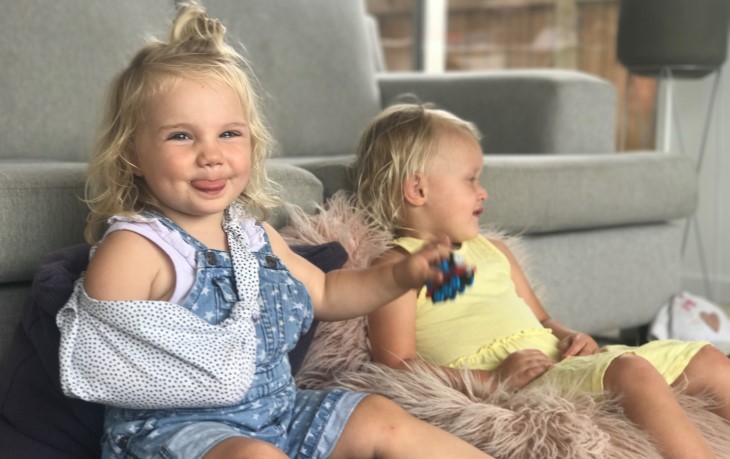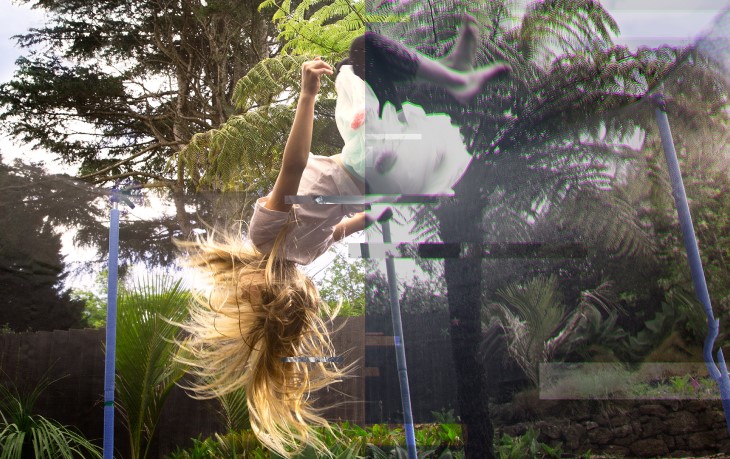Jump in trampoline injuries: Seven tips to prevent injury

Playing on the trampoline is an iconic summer pastime for kids in Aotearoa. But for many, a jump on the tramp ends with an injury. This is Winnie's story.
Te Atatu mum Andrea Fountain knew something was up when her 13-month-old daughter Winnie wouldn't take her bottle.
Moments before the accident in 2018, Winnie and older brother Waimana (24 months) had been playing on their trampoline when a sibling-rumble kicked off.
"Like a typical older brother, Waimana wanted his sister off the tramp and gave her a good push through the flaps," says Andrea.
"Winnie has a real death grip and she held onto the netting for dear life before she fell, and the force broke her collarbone."
Andrea had her hands full. She was home alone with two young kids and she can still feel the stress and the drama from the accident.
"It was pretty stressful. Winnie was screaming and in a lot of pain and she wouldn't stop crying," she says.
"I gave her a bottle to settle her down, but she couldn't drink it because she couldn't lift her arm. I knew then it was serious, and her arm was broken."
Winnie had X-rays at A&E which confirmed the fracture. They were told that it would take up to six weeks for her collarbone to heal. ACC covered all of her medical expenses to help her rehabilitation.
"Having an injured child is not easy, especially when they're young and you're trying to get them dressed, bathed, and fed. It was a challenging time there for a while."
ACC accepted claims for 12,669 trampoline-related injuries in 2020 which came at a cost of $10.6 million to help people recover. This cost was the highest in the past 10 years.
Andrea, who grew up on trampolines herself, said her family are more safety-conscious following Winnie's injury.
"I love tramps, they're heaps of fun, but they can be pretty dangerous. And my kids always like to push the boundaries.
"We try to do one at a time now but it's not easy with kids who always want to play and have fun together. After that injury, we always watch them on the tramp because injuries can happen so easily."
Tramps are part of growing up
ACC Injury Prevention Leader Kirsten Malpas says having fun on the trampoline is a huge part of growing up as a kid in New Zealand.
"I remember when I was a kid, I would spend hours with my mates on the tramp, making up games and having fun. That's still the same today for my kids which is awesome, it's a place where you learn and grow," she says.
"But because of this, the trampoline is a place where a lot of injuries can happen and many of these accidents are preventable.
"We want whanau all over Aotearoa to have fun, enjoy their time together and to play safely on their trampolines without injury."
Falls are the leading cause of trampoline-related injuries (95%). The falls were in three main types:
- off the tramp – onto grass, pebbles, concrete, ground surface
- on to the metal frame/edge or trampoline/bars/springs
- through the safety net or springs.
Other causes of injury include colliding with others on the trampoline, landing on objects on the trampoline, and jumping onto the tramp from outside from a tree or fence.
"So by taking a moment to assess the risk, many of these injuries are preventable."
With the introduction of safety nets, pads and zips, trampolines have come a long way in the past 20 years and Kirsten encouraged families who own older models to ensure they have pads covering the springs and metal frames.
Kirsten says the most common injuries from trampoline accidents are ankle sprain (12%) and neck sprain (8%). The data also shows that fractures occurred in 80% of trampoline-related hospital admissions.
The recovery time varies for a fracture, but they typically take six to eight weeks to heal.
"It means that kids are out of action for a long period and unable to do the things that they love like playing other sport or music or swimming this summer.
"Many of these injuries are preventable so we recommend taking your time to make sure the trampoline is in a safe place to avoid injury."
Seven tips for safe use of trampolines
- Actively supervise children.
- Reinforce safety rules, including only one person using the trampoline at a time.
- Ensure the trampoline meets the New Zealand or Australian safety standard. The New Zealand standard is NZS 5855:1997 Consumer safety specification for components, assembly, and use of a trampoline.
- Follow manufacturer's guidelines for assembly, positioning, maintenance, and use.
- Always use safety pads.
- Ensure pads and nets are correctly installed.
- Regularly inspect and maintain trampoline, and replace damaged parts. Don't use water, detergent, or other objects on the trampoline.




